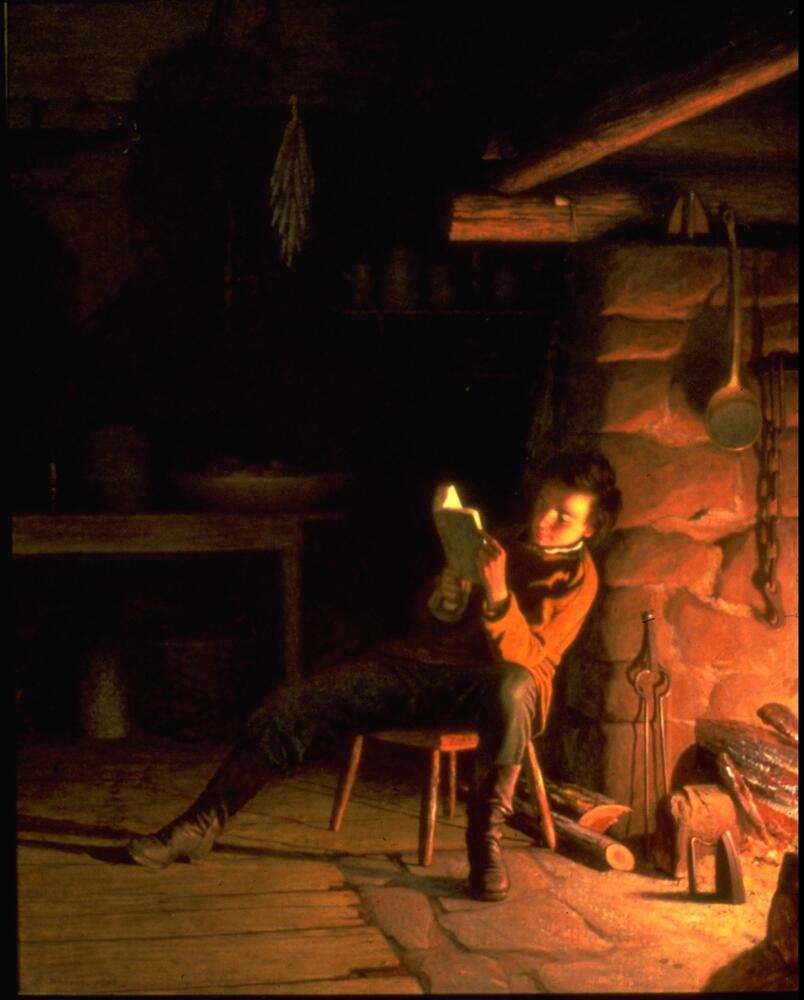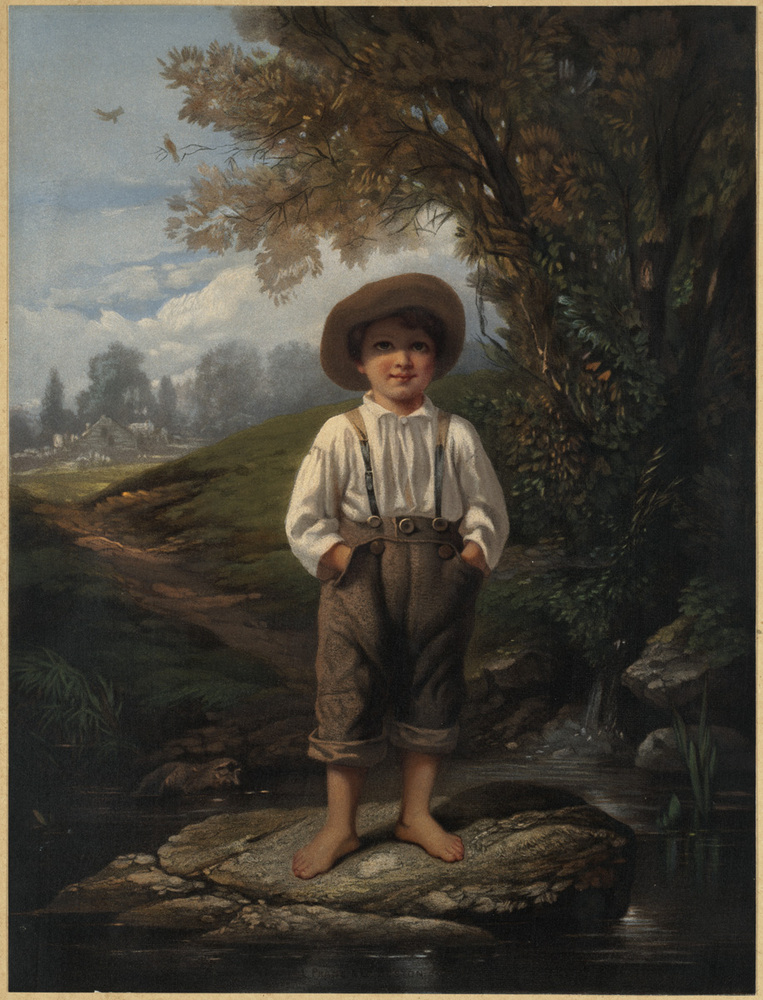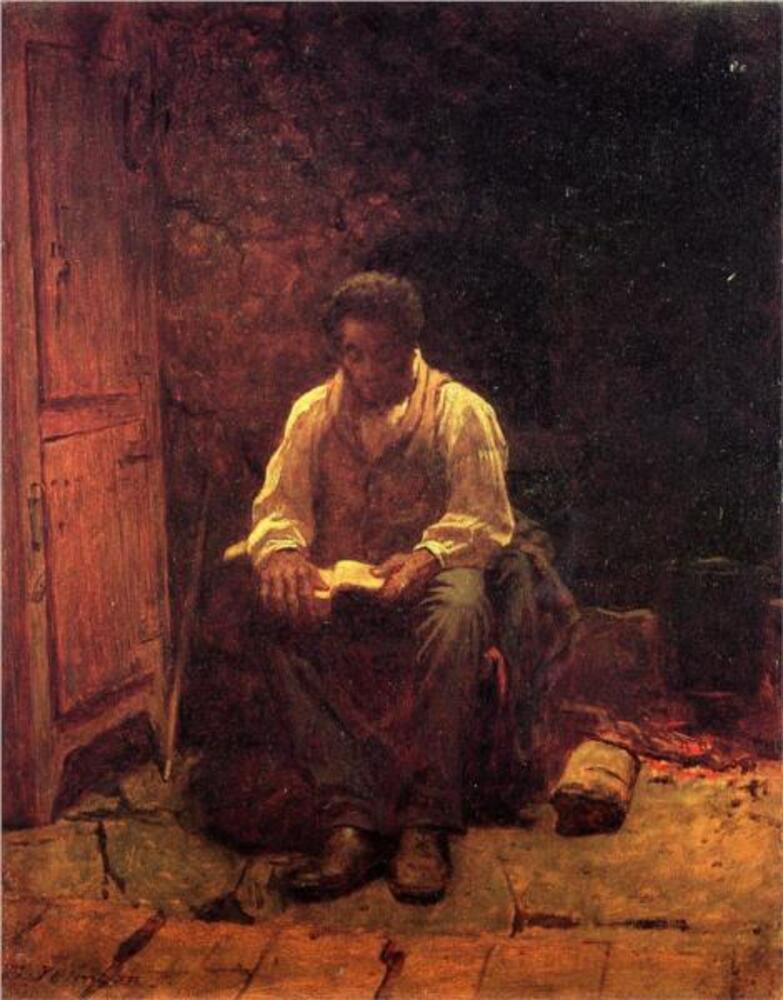Eastman Johnson's The Boyhood of Lincoln: Awakening Faith in the Future
Resource Authors: Riya Patel, Elizabeth Vice, Sophie Struyk, Jackie Groves, Isabelle Popp
Introduction
This resource page analyzes Eastman Johnson and his work titled The Boyhood of Lincoln. Johnson's experience in life and art coupled with the climate of the nation around 1868 aided in understanding the success of the Boyhood of Lincoln. We discuss the upbringing of Johnson and how he was initially inspired to create art, there is a shift in his work which shows his versatility and realism in art. Then we dig into The Boyhood of Lincoln itself as we discuss the reception of it along with the context of the subject and cultural context.
Artist Biography
Early Exhibitions and Publications of The Boyhood of Lincoln: The Reception of It
When the Boyhood of Lincoln was created in 1868, at the time, there were many feelings of loss because Abraham Lincoln was assassinated just three years prior. Lincoln's role in the Civil War showcased him as a national leader and helped the nation define its long-awaited national identity. Due to this, the Boyhood of Lincoln became a prominent piece that was displayed and respected at many exhibitions. Specifically, depicting Lincoln in his childhood is what made this piece touch the hearts of viewers. Following the Civil War, many Americans believed that the fate of the nation rested in the youth. Hill explains how childhood symbolizes innocence, growth, purity, and spontaneity which are the needed qualities to rebuild a war-torn nation (1974). There was a wide emergence in the sentimental genre which can be attributed to the escapist view in response to the post-Civil War era (Drachler 1980). During that time period, the piece was considered a work of great value and interest because it communicated various appealing themes. For example, Henry Lewis purchased the Boyhood of Lincoln and through his graciousness, the painting stands at the UMMA today. He was drawn to it because of the popular theme of education. Lewis pursued learning through self-guided books under less than ideal conditions. Because Johnson is able to make the piece appealing to many people through the themes, in a publication Patricia Hill contributes this to Johnson by stating that he had a “gift for sensing subjects of topical interest”
Following this, Louis Prang started his company L. Prang and Co in 1860 where through chromolithography, he created a market for prints in America (Clapper 2002). Chromolithography is a method used to make multiple color prints of a piece that resemble the original painting. Although new at the time, this technique made it possible for important and valuable pieces to be distributed so people all over the nation could enjoy them. Prang was specific about what to print and choose pieces that were highly acclaimed in the media and by the public. The Boyhood of Lincoln was on the pricier side as Prang paid Johnson $800 to buy it in order to use it for chromolithography. To put the value of this piece in context, Prang sold the piece later for $780 and another work by Johnson called Barefoot Boy was sold for $420. Both works display themes and appeal of rural childhood during that time. This provides evidence that the piece was a subject of interest and was valued so much to the extent that there was a market for copies of the piece and it was distributed widely.
Overall, the Boyhood of Lincoln was a successful piece because it gave hope in a post-war era, and its prominence of it in the emergence of chromolithography proves it.
The Boyhood of Lincoln in Context: Comparison to Other Works
In the years before and after Boyhood of Lincoln, Eastman Johnson spent his time exploring the concepts of a “Yankee Identity” and the northern United States’ social culture, ultimately coming to the conclusion that commitment to an honest day’s work, perseverance, and the initiative was central to this identity, more so than race. During his life, Johnson was appreciated for his “strong common sense and a Yankee shrewdness,” and his works were regarded as “representative American” art, favoring the down-to-earth, no-nonsense attitude of the Northern United States (Benjamin 1882, 6). Johnson’s portrayals of the greater Northern identity were appreciated for sharing values such as determination and discipline and were also fairly progressive for his time, as his definition of the Northern identity surpassed the boundaries of race, favoring instead a greater social culture and moral code as unifying forces.
Johnson began this exploration by crafting portraits of members of the Anishinabe tribe in the late 1850s, but perhaps most notably, Johnson portrayed the identity of Northerners through his Maple Sugar Projects, painted from the early 1860s into the 1870s. These paintings depict common people crafting maple syrup in all its stages of production, an industry that was regarded as distinctly northern. These paintings reflect the “social and technological upheaval of the time and reinforce the ideals of free labor during the tumult of the Civil War” (Allen 2004, 11). Johnson paints unglamorized working people, shown as honorable for their commitment to hard work and discipline. Maple sugar was one of few American industries that were completely untouched by slavery and were often deemed the “innocent” version of cane sugar. Additionally, maple syrup was heavily influenced by Native American production traditions. Through these factors, Johnson portrayed the greater American identity as something influenced by other cultures, challenging the notion of a Whites-only American identity.
Johnson’s discussion of race in relation to the Yankee identity is certainly related to Boyhood of Lincoln, especially when paired with his painting The Lord is My Shepherd. Painted in 1863, the year the Emancipation Proclamation went into effect, it depicts a young Black man learning to read using the Bible. According to curator Eleanor Jones Harvey, Johnson shows how literacy was one of the ways previously enslaved people attempted to “prove that they were worthy of being considered whole people '' and Americans (0:52-0:56). Johnson painted the formerly enslaved man with the same grace that he used with Lincoln in Boyhood of Lincoln. He incorporated African-Americans into the larger American identity by portraying reading as a skill for everyone to learn, Black and White alike; reading is shown to be something sacred and righteous. Additionally, the man has Union military apparel, strengthening his connection to Lincoln. Just as the maple workers and formerly enslaved men were admired for their work ethic, Lincoln was hailed for achieving greatness despite his humble beginnings, some of which viewers see through his simple cabin home in Boyhood of Lincoln. Johnson asserted that dedication and initiative are central to the American identity, more so than race.
The Boyhood of Lincoln: The Subject
Something very notable about Johnson was his social standing. Johnson was born in Maine to a business-owning family and grew up to become secretary of state. This political alignment shows that Eastman did not dedicate his entire life to painting and that it was significant for him in creating a piece like Boyhood Of Lincoln which represented the President Of the United States. His father was a business owner, and also being the one to have inspired and pushed Jhonson to become an artist and politician in many ways. This also can be reflected in many of his paintings of well-known individuals in the time period, like relatives of George Washington and more notably Abraham Lincoln as a young boy in ‘Boyhood Of Lincoln’.
The painting ‘Boyhood Of Lincoln’ by Eastman Johnson works to humanize and emphasize President Lincoln's upbringing. The painting displays the 16th president as a young boy reading a book Johnson used oil on canvas to create this painting in 1868 three years after the passing of Lincoln. Johnson was a painter known for displaying and painting Americans in their everyday lives and used a realistic style. He painted many portraits of wealthy and influential individuals but also painted strangers. Johnson uses his skills and portraiture to humanize and display a young Lincoln, the reason this was found to be so appealing was due to the lack of accessibility/invention of cameras in Lincoln's youth and age in which many politicians might not have been represented in. The palette and tones used in many of Johnson's paintings are reflected in the Boyhood Of Lincoln; the use of amber and dark shading in the corner emphasizes and highlights the lifestyle Lincoln grew up in. Along with the tone of the painting, the realistic style of portraiture that Johnson used works to emphasize the youth of Lincoln with the details of his face posture, and surroundings.
The location of the painting is the rural farm home of Indiana, Lincoln's Boyhood cabin home that shows his ‘modest’ lifestyle. The location is a key part of the subject by showing a part of more rural America, creating a connection for many of the audience in the 19th century in the aftermath of the civil war and Lincoln's death. The subject might appeal to many working-class Americans by showing this log house. The painting's subject overall shows Lincoln as a young man at his young reading beside the fire in his childhood home.
Cultural Context
The cultural context of Eastman Johnson’s Boyhood of Lincoln is extremely parallel to the time period in which the painting was made. The Boyhood of Lincoln was painted in 1868, during which time America was undergoing rapid and dramatic changes due to industrialization. Because of industrialization American citizens' lives were changing rapidly with the introduction of railroads which allowed movement across the country to be more accessible, people’s lives were more changed both physically in location and socially in class. This created an overarching longing for works of art that gave people a common identity; a longing very well satisfied by most of Johnson’s works.
To hone in on the Boyhood of Lincoln we must take a look at the context of Lincoln's presidency; this painting was created just three years after his assassination. In terms of the cultural context, very timely. The intention of this painting was to pay some sort of tribute to Lincoln and his quest for knowledge as a president. This can be seen as Lincoln is depicted reading by a fire, showing a boy who had an interest in education from a very young age; a boy who started from very humble beginnings and evolved through knowledge into a wise great man. The main aspect a viewer gets from just gazing at the painting is the humbleness of the setting. It was very well known that Lincoln had humble beginnings, however, Eastman Johnson's work was one of the first to depict it visually. This aspect of the painting is what makes it so special and culturally significant and connects it back to the mentioned earlier about the popularity of artwork that had a quaint familiarity to most Americans at the time.
Bibliography
2022. “Eastman Johnson.” Smithsonian American Art Museum, Smithsonian
Curator Eleanor Jones Harvey’s video called “Episode 4 - Podcast: The Civil War and American Art” analyzes one of Johnson’s works, The Lord is My Shepherd, which was a response to the Emancipation Proclamation. This video talks about the significance of showing a previously enslaved man learning to read, noting his Union military items and ties to Lincoln.
Allen, Brian T. 2004. Sugaring Off, The Maple Sugar Paintings of Eastman Johnson. Sterling and Francine Clark Art Institute.
This source explores Johnson's Maple Sugar series of paintings. It gives a visual analysis of this collection, but also provides the context and social relevance of these works. It places them in context with the Civil War and other events, as well as explains how they were received at the time of production.
Bakes, John. “Eastman Johnson- The Famous Painter Dead at New York- A Native of Maine.” Daily Kennebec Journal. April 7, 1906.
Baur, John L. An American Genre Painter: Eastman Johnson 1824-1906, 1940.
Benjamin, S. G. W. 1882. “A Representative American.” Magazine of Art, vol. 5, ProQuest.
This primary source talks about how Johnson and his works were viewed in his time. It specifically discusses a “Yankee quality” to Johnson that made it particularly relevant to this essay.
Clapper, Michael. “‘I Was Once a Barefoot Boy!’: Cultural Tensions in a Popular Chromo.” American Art 16, no. 2 (2002): 17–39.
The author compares the Barefoot Boy and the Boyhood of Lincoln to show similarity and reasoning as to why they were chosen for chromolithography. The process as well as Louis Prangs' motivation and interest in the Boyhood of Lincoln are showcased.
Drachler, Carole S. The Gallery And Art Collection Of Henry Clay Lewis, University of Michigan, Ann Arbor, 1980. ProQuest.
This text goes through the entire art collection of Henry Clay Lewis and explains his interests in the pieces he purchased. Through this text, the motivation behind Lewis purchasing the Boyhood of Lincoln is revealed along with the demand for the piece at the time.
Hills, Patricia. “The Genre Painting of Eastman Johnson : The Sources and Development of His Style and Themes.” Book. Outstanding Dissertations in the Fine Arts. New York: Garland Pub., 1977.
Hills, Patricia. “The Painters’ America: Rural and Urban Life, 1810-1910.” Book. New York: Praeger, 1974.
Created For
K-12 EducatorK-12 Student
Museum Visitor
UMMA Docent
UMMA Staff
University Faculty
University Student
Rate this Resource
AVG: 0 | Ratings: 0
& Author Notes
Creative Commons by-nc-saLast Updated
April 21, 2022 4:34 a.m.Report
Reporting Policy




